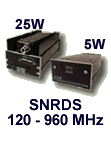
|
|
Spread Sprectrum Application NotesThe "Wireless Revolution" will be driven by radio technology developed during World War II to protect military and diplomatic communications. From this cloak-and-dagger genealogy, spread spectrum radio is developing into a core technology for today's wireless challenges. While available for many years, spread spectrum radio was employed almost exclusively for military use. In 1985, the FCC allowed spread spectrum's unlicensed commercial use in three frequency bands-902 to 928 MHz, 2.4000 to 2.4835 GHz and 5.725 to 5.850 GHz. Spread spectrum radio differs from other commercial radio technologies because it spreads, rather than concentrates, its signal over a wide frequency range within its assigned bands. The two main signalspreading techniques are direct sequencing and frequency-hopping. Direct sequencing continuously distributes the data signal across a brad portion of the frequency band. This technique modules a carrier by a digital code with a bit rate much higher than the information signal bandwidth. Frequency-hopping radios move a radio signal from frequency to frequency in a fraction of a second. True to its military heritage, spread spectrum camouflages data by mixing the actual signal with a spreading code pattern. Code patters shift the signal's frequency or phase, making it extremely difficult to intercept an entire message without knowing the specific code used. Transmitting and receiving radios must use the same spreading code, so only they can decode the true signal. Obviously, spread spectrum radio is not the only wireless technology available. But in specific applications, its inherent attributes make it the technology of choice over traditional microwave radio or the optical technologies such as infrared and laser transmission, particularly in "last mile," "where wires can't go" or hostile environment applications. The most recent spread spectrum WAN/LAN developments have come through the integration of the radio with a full-function Ethernet bridge. A wide range of commercial spread spectrum products are being developed in response to the 1985 FCC Part 15 ruling. The key to commercializing spread spectrum is overcoming its complexity and cost. Most of the complexity in direct sequence radios resides in digital processing (DSP) or custom-designed chips. Today, all kinds of complex processing are available in the form of low-cost chips in everyday products. As practical commercial applications become better understood, spread spectrum will play an increasingly critical role in a world destined to depend on wireless technology. |
SIMREX Corporation, 1223 William St., Buffalo NY 14206 . Ph. 716-206-0174

